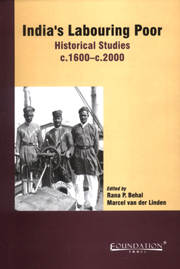Book contents
- Frontmatter
- Contents
- Notes on Contributors
- Frontispiece
- Preface
- Introduction
- Working Across the Seas: Indian Maritime Labourers in India, Britain, and in Between, 1600–1857
- The Brickmakers' Strikes on the Ganges Canal in 1848–1849
- On the Move: Circulating Labour in Pre-Colonial, Colonial, and Post-Colonial India
- Mobility and Containment: The Voyages of South Asian Seamen, c. 1900–1960
- Power Structure, Discipline and Labour in Assam Tea Plantations during Colonial Rule
- “Following Custom”? Representations of Community among Indian Immigrant Labour in the West Indies, 1880–1920
- Masculinity, Respect, and the Tragic: Themes of Proletarian Humor in Contemporary Industrial Delhi
- Stretching Labour Historiography: Pointers from South Asia
- DOCUMENT
- Select Bibliography
The Brickmakers' Strikes on the Ganges Canal in 1848–1849
Published online by Cambridge University Press: 05 January 2012
- Frontmatter
- Contents
- Notes on Contributors
- Frontispiece
- Preface
- Introduction
- Working Across the Seas: Indian Maritime Labourers in India, Britain, and in Between, 1600–1857
- The Brickmakers' Strikes on the Ganges Canal in 1848–1849
- On the Move: Circulating Labour in Pre-Colonial, Colonial, and Post-Colonial India
- Mobility and Containment: The Voyages of South Asian Seamen, c. 1900–1960
- Power Structure, Discipline and Labour in Assam Tea Plantations during Colonial Rule
- “Following Custom”? Representations of Community among Indian Immigrant Labour in the West Indies, 1880–1920
- Masculinity, Respect, and the Tragic: Themes of Proletarian Humor in Contemporary Industrial Delhi
- Stretching Labour Historiography: Pointers from South Asia
- DOCUMENT
- Select Bibliography
Summary
INTRODUCTION
For a long time it seemed indisputable that collective actions of wage labourers in general and strikes in particular were a typically European and American phenomenon, closely linked to the Industrial Revolution and its consequences. Modern imperialism and the concomitant spread of industrialization and modernization brought these phenomena to the rest of the world. Some decades ago, however, an awareness arose that even before that famous watershed in history people knew how to organize a strike. Although this critical reappraisal of the supposed link between the Industrial Revolution and labour tactics led, albeit slowly, to a renewal of interest in the early labour history of Europe, its implications for the labour history of other continents have not yet received the attention they deserve. If we want to take that next step, the question could be formulated as follows: “If strikes could take place in pre-industrial Europe, why not also in other pre-industrial parts of the world?”
At first sight such a question does not seem very useful for India if we follow the line of argument put forward most eloquently by Dipesh Chakrabarty. Since his influential studies from the 1980s on the Calcutta jute-mill workers, the historiography of Indian labour can be characterized – in the words of Deep Kanta Lahiri Choudhury – as follows: “Studies began from the 1880s and characterized the period 1880–1919 as the ‘prehistory’ of labour mobilization in India and as the period of the emergence of ‘community consciousness’ within Indian labour.”
- Type
- Chapter
- Information
- India's Labouring PoorHistorical Studies, 1600-2000, pp. 47 - 84Publisher: Foundation BooksPrint publication year: 2007
- 2
- Cited by



